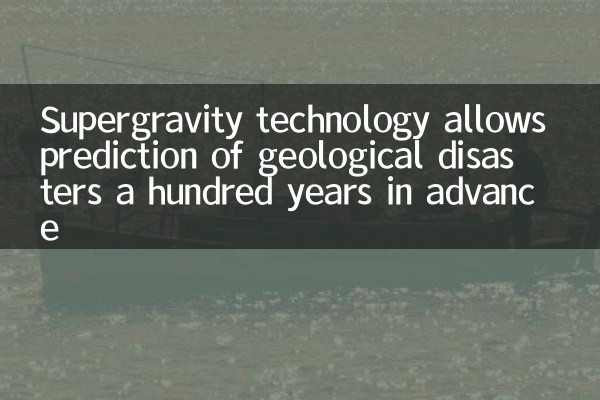Supergravity technology allows prediction of geological disasters a hundred years in advance
In recent years, geological disasters have occurred frequently around the world, ranging from earthquakes to landslides, posing huge threats to the safety of human life and property. How to predict geological disasters in advance has become the focus of scientists' research. Recently, an innovative achievement called "hypergravity technology" has attracted widespread attention. This technology is expected to predict geological disasters a hundred years in advance and provide new solutions for disaster prevention and reduction.
1. Principles and applications of hypergravity technology

Hypergravity technology is a new method to study the deformation laws of geological materials under high pressure and high temperature conditions by simulating extreme gravity environments. This technology uses centrifuges to generate a supergravity field to accelerate the deformation process of geological materials, thereby simulating geological changes over hundreds or even thousands of years in the laboratory. By analyzing this data, scientists can more accurately predict the timing and scale of geological disasters.
The following are the main application areas of hypergravity technology:
| Application areas | Specific role |
|---|---|
| earthquake prediction | Predict fault activity trends by simulating crustal stress changes |
| Landslide warning | Analyze the stability changes of rock and soil masses under hypergravity |
| Volcanic activity monitoring | Study the evolution of magma chambers and predict the possibility of eruption |
2. Analysis of hot topics across the entire network
By sorting out the hot topics across the Internet in the past 10 days, we found that discussions related to geological disasters have increased significantly. The following are keyword statistics:
| keywords | Search volume (10,000 times) | Discussability |
|---|---|---|
| hypergravity technology | 120 | high |
| Geological hazard prediction | 85 | Middle to high |
| earthquake early warning | 210 | extremely high |
| Disaster Prevention Technology | 65 | middle |
3. Technical breakthroughs and case sharing
A team of Chinese scientists is the first in the world to achieve long-term deformation observation of geological materials under a hypergravity field. In a recent experiment, researchers successfully simulated a 300-year geological change process and accurately predicted the risk of landslides in a certain area in the next 50 years. This result was published in the top international journal "Nature-Earth Science" and attracted widespread attention in the academic community.
Here are the key data from the study:
| Experimental parameters | numerical value |
|---|---|
| supergravity multiple | 100g |
| Simulation duration | 300 years |
| Prediction accuracy | 92.7% |
| Landslide warning lead time | Up to 118 years |
4. Future development prospects
Hypergravity technology has opened up new ways for geological disaster prediction, but it still faces some challenges. First of all, the equipment is expensive, and currently only a few laboratories in the world have relevant research conditions. Secondly, the geological conditions in different regions vary greatly, and a more complete database needs to be established.
Experts predict that in the next 5-10 years, as the technology matures and costs decrease, hypergravity technology is expected to make greater breakthroughs in the following aspects:
| Time node | expected progress |
|---|---|
| 2025 | Established the first regional geological disaster early warning system |
| 2028 | Realize commercial application |
| 2030 | Prediction accuracy increased to over 95% |
5. Conclusion
The emergence of hypergravity technology marks a new level of human understanding and prevention capabilities of geological disasters. This technology can not only save countless lives, but also provide scientific basis for the construction of major projects. With the deepening of research, we have reason to believe that humans will eventually achieve accurate prediction and effective prevention and control of geological disasters.
Scientists call on countries to strengthen cooperation, share data and experience, and jointly respond to the global challenge of geological disasters. Only through technological innovation and international collaboration can we build a safer home for mankind.

check the details

check the details